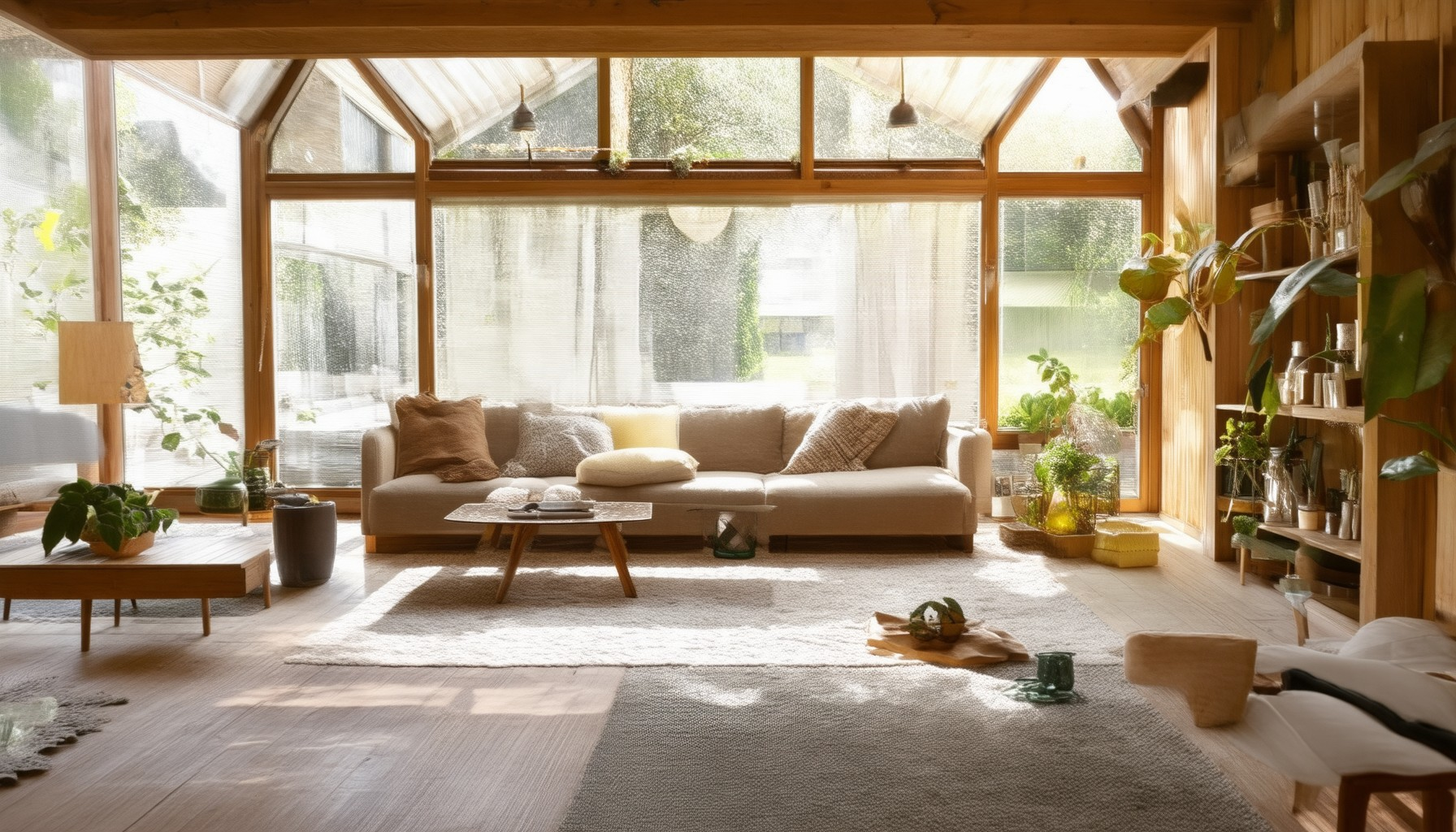Building a sustainable home or improving your current living space with eco-friendly materials is one of the most impactful decisions you can make for both your health and the environment. With the growing demand for sustainable living, there’s a wide range of eco-friendly home materials available that not only reduce your carbon footprint but also offer long-term benefits for your family. From flooring and insulation to paint and furniture, the options for eco-friendly materials are diverse and versatile, catering to different budgets and preferences. In this comprehensive guide, we’ll explore everything you need to know about selecting the best eco-friendly home materials, including their environmental impact, cost-effectiveness, and practicality. Whether you’re renovating your home, building from scratch, or simply looking to incorporate more sustainable practices, this guide will provide you with valuable insights and recommendations to help you make informed decisions.

Most Eco-Friendly Materials for Building a House
The most eco-friendly materials for constructing a house vary based on factors like carbon footprint, renewability, and local availability. Here are some top options:
- Wood : Wood is highly sustainable when sourced from responsibly managed forests. It sequesters CO2, reduces the carbon footprint, and lasts longer with proper care. Look for FSC-certified wood for optimal environmental impact.
- Bamboo : A rapidly growing material, bamboo is lightweight, strong, and sustainable. It requires less energy to produce and can be used for various structural elements.
- Recycled Steel : Using recycled steel reduces the need for raw materials and lowers energy consumption. It’s durable and can be formed into beams and columns.
- Clay and Earth-Based Materials : These are locally sourced and have a low embodied energy. Clay walls are insulating and long-lasting, making them a great choice for eco-conscious builds.
- Modular Construction : Prefabricated components reduce waste and allow for better control over materials, though transportation and manufacturing energy should be considered.
When choosing, consider certifications like FSC for wood and regional availability to maximize sustainability and cost-effectiveness.
What Are Eco-Friendly Home Products?
Eco-friendly home products are items designed to minimize environmental impact while still offering functionality and aesthetic appeal. These products often use sustainable materials, reduce waste, and promote energy efficiency.
Kitchen Essentials
- Bamboo cutting boards – durable and renewable resource
- Glass food storage containers – reduces plastic waste
- Compostable kitchen scraps collector – helps reduce landfill waste
- Sustainable cookware made from stainless steel or ceramic
- Reusable cloth napkins and dishcloths – replaces disposable ones
Bathroom Basics
- Biodegradable toilet paper – made from recycled paper
- Recycled cotton towels – soft and eco-friendly
- Refillable soap dispensers – reduces plastic packaging
- Compostable toilet seat covers – made from plant-based materials
- Low-flow showerheads – conserves water
Home Decor
- Bamboo flooring – renewable and sustainable
- Cotton curtains and bedding – breathable and eco-friendly
- Recycled metal or wood furniture – repurposed materials
- Herb pots made from clay or recycled materials
- Eco-friendly paint – low-VOC and water-based
Clothing and Textiles
- Organic cotton t-shirts – safe for skin and environment
- Bamboo clothing – breathable and sustainable
- Recycled polyester jackets – reduces textile waste
- Plant-based dye fabrics – less harmful chemicals
- Upcycled fabric products – transforms waste materials
Electronics and Appliances
- Solar-powered chargers – renewable energy source
- Smart thermostats – energy-efficient heating
- Appliances with Energy Star certification
- Rechargeable batteries – reduces electronic waste
- Recycled aluminum cans – supports recycling programs
Cleaning Supplies
- Plant-based cleaning detergents – safer for the environment
- Microfiber cloths – reusable and effective
- Recycled paper towels – reduces paper usage
- Compostable cleaning wipes – biodegradable
- Non-toxic cleaning products – healthier for families
By incorporating these eco-friendly home products into your daily life, you can significantly reduce your carbon footprint while maintaining a comfortable and stylish living environment. Remember to always check for certifications like FSC or Forest Stewardship Council for wood products and look for products made from responsibly sourced materials.

What Material Is Environmentally Friendly?
- Linen: Made from flax plants, linen is durable, biodegradable, and requires minimal resources to grow and process.
- Straw: A natural fiber obtained from wheat, barley, or rye, straw is lightweight, biodegradable, and can be used for various applications like packaging and insulation.
- Clay: Used in production of tiles and pottery, clay is a natural material that can be recycled and has low embodied energy.
- Stone: A natural material found in abundance, stone is long-lasting and can be used for construction and flooring, reducing the need for replacement.
- Sand: A natural resource used in construction and manufacturing, sand is abundant and can be reused in various applications.
- Beeswax: Derived from bee pollen, beeswax is used in candle-making and is fully biodegradable.
- Hemp: A highly renewable material, hemp grows quickly and requires little water, making it ideal for textiles, paper, and building materials.
- Bamboo: A fast-growing plant, bamboo is sustainable and can be used for flooring, furniture, and clothing due to its versatility and durability.
- Cork: Obtained from the bark of cork oak trees, cork is lightweight, buoyant, and excellent for insulation and packaging, as it is biodegradable and regenerates after harvesting.
- Recycled Materials: Using materials that have already been used, such as aluminum, steel, and plastic, reduces the demand for raw resources and lowers energy consumption.
- Agricultural Residues: Byproducts from farming operations, such as rice husks and corn cobs, can be repurposed into materials like bioplastic and animal feed, reducing waste.
- Sustainably Harvested Wood: Wood that is harvested in a way that ensures the forest remains healthy and can regenerate, often certified by organizations like FSC (Forest Stewardship Council).
Note: When selecting materials, consider certifications like FSC or PEFC to ensure sustainable practices are in place.
Learn more about sustainable materials and practices

What is a sustainable material to make a house out of?
Sustainable materials offer eco-friendly alternatives for constructing homes while minimizing environmental impact. Here are some top choices:
- Recycled Steel : Made from scrap metal, it reduces the need for raw steel production, lowering carbon emissions significantly. Learn more about recycled steel
- Cypress Pine : A durable and renewable resource, it grows quickly and requires less maintenance compared to traditional timbers. Explore cypress pine houses
- Bamboo : Lightweight yet strong, bamboo is a rapidly renewable material that sequesters carbon and requires fewer resources to grow. Discover bamboo housing options
- Concrete : While often associated with high emissions, modern low-carbon concrete uses industrial byproducts, reducing its environmental footprint. See sustainable concrete applications
- Clay Bricks : Made from natural clay, bricks are long-lasting and require little maintenance. They also absorb CO2 during manufacturing. Find out about clay brick construction
- Aluminum : Recycled aluminum is highly durable and lightweight, contributing less to waste and environmental strain. Check out aluminum house designs
- Sustainable Plastics : Made from non-toxic, biodegradable materials, these plastics can be used for structural components and insulation. Understand plastic housing solutions
By choosing these sustainable materials, you can reduce your home’s environmental impact while enjoying long-lasting durability and style.
Examples of Green Building Materials
Green building materials are products and substances that have been sourced or processed with minimal environmental impact, reducing their carbon footprint and promoting sustainability. Here are some popular examples:
- Bamboo – A rapidly renewable resource used for flooring, paneling, and construction.
- Recycled Steel – Made from scrap metal, it reduces energy consumption and minimizes waste.
- Cork – A natural insulation material extracted from tree bark, known for its thermal and acoustic properties.
- Low-VOC Paints and Adhesives – These products emit fewer harmful chemicals, improving indoor air quality.
- Concrete with Fly Ash – Incorporates fly ash, a byproduct of coal combustion, to reduce the material’s environmental impact.
- Insulated Glass – Used in windows and doors, it helps reduce heat loss and energy usage.
- Photovoltaic Tiles – Integrated into roofing materials, they generate electricity from sunlight.
- Geothermal Heat Pumps – Efficient systems that use the Earth’s stable underground temperature to heat and cool buildings.
- Eco-Friendly Bricks – Made from recycled materials or natural clay, they offer lower embodied energy.
- Sustainable Wood Products – FSC-certified wood, which ensures responsible forestry practices.
For more information on selecting and utilizing green building materials, visit our website .

Is 100% Cotton Sustainable?
Yes, 100% cotton can be considered sustainable under certain conditions. However, its sustainability depends on how it is grown, processed, and disposed of. Below are key factors to consider:
- Water Usage: Cotton farming is highly water-intensive, often requiring significant irrigation. Sustainable practices, such as drip irrigation and rainwater harvesting, can reduce this.
- Pesticide and Fertilizer Use: Conventional cotton often relies on synthetic pesticides and fertilizers, which can harm the environment. Switching to organic cotton reduces chemical inputs and improves soil health.
- Genetic Engineering: The development of genetically modified cotton seeds has increased yields but raises concerns about long-term sustainability and pesticide resistance.
- Energy Consumption: Processing cotton into textiles requires energy. Implementing renewable energy sources in manufacturing can enhance sustainability.
- Carbon Footprint: Transportation and processing contribute to the cotton’s carbon footprint. Optimizing logistics and using eco-friendly transport methods helps reduce this.
Environmental Impact of Cotton
Cotton production contributes significantly to deforestation, habitat destruction, and water pollution due to excessive pesticide use. However, organic cotton and sustainable farming practices can mitigate these issues.
Benefits of Sustainable Cotton
- Organic Cotton: Grown without synthetic chemicals, organic cotton is better for soil health and biodiversity.
- Biodegradability: Cotton is biodegradable, breaking down in 3-6 months in compost, returning nutrients to the soil.
- Reduced Waste: Cotton products are durable, reducing the frequency of replacements and waste.
Conclusion
Sustainable cotton practices, such as organic farming and efficient resource use, make 100% cotton a more environmentally friendly option. However, it’s essential to choose products made from sustainably sourced cotton to fully benefit from its advantages.
For more insights into sustainable living and home improvement tips, visit our Sustainable Living section.





0 Comments